Introduction to Performance Management in Business Organization
- Other Laws|Blog|
- 18 Min Read
- By Taxmann
- |
- Last Updated on 16 October, 2023
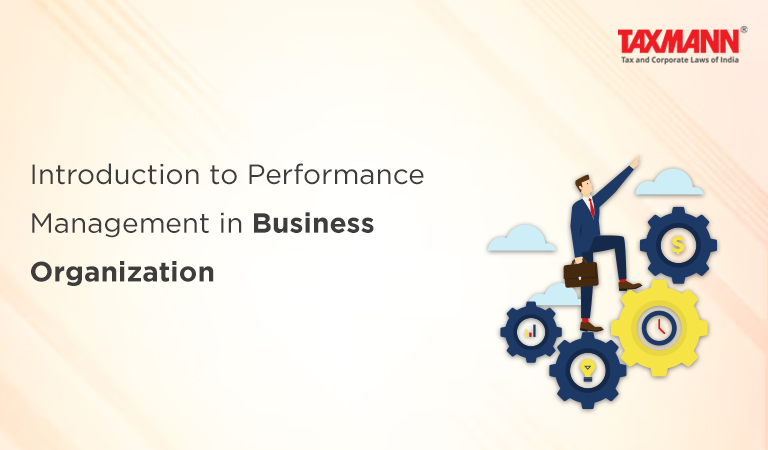
Table of content
- Introduction
- Nature of Performance Management
- Role of Performance Management in Business Organization
- Significance of Performance Management
- Principles of Performance Management
- Goals of Performance Management
- Performance Appraisal
- Objectives of Performance Appraisal
- Difference between Performance Appraisal and Performance Management
- Sample Performance Appraisal Form
- Appraisal Interview Hints for Supervisors and Managers
- Conducting Performance Review
- Steps to Effective Review
- Key Performance Review Questions
- Prerequisites for Effective & Successful Performance Appraisal
- Effective Performance Management System
- Characteristic of a High Performance Work System
- Purpose of the PAS
- Performance Management Linkage
- Components of Performance Focused Culture
- Techniques of Performance Appraisal
- Criteria of Performance Management
- Process of PA
- Different Methods of Appraisals
- Traditional Methods of Performance Appraisal
- Modern Methods of Performance Appraisal
- The MBO Process
- Features and Advantages MBO
Check out Taxmann's Human Resource Management | Text and Cases which is a comprehensive Human Resource (HR) handbook (covering all the basic & advanced aspects) which deals with a strategic approach to Human Resource Management. It presents the link between theory, practice, critical thinking and current examples relevant to the present industry.
1. Introduction
The words of Oliver Sheldon
“No industry can be rendered efficient so long as the basic fact remains unrecognized that it is primarily human. It is not a mass of machines and technical process but a body of men. It is not a complex of matter, but a complex humanity. It fulfils its functions not by virtue of some impersonal force but by human energy. Its body is not an intricate maze of mechanical devices but a magnified nervous system”.
In view of that, many progressive organizations have started giving importance to the people factor.
Before we understand what is Performance management we must clearly understand three important terms which are very essential :
- Performance: Achievement of the goals against the target set
- Competency: Knowledge, skills & attitude required to perform the role effectively
- Potential: Capacity of individual to handle the responsibilities based on his ability and current competency level.
Performance Management includes the performance appraisal process which in turn helps identifying the training needs and provides a direction for career and succession planning. Faced with a host of new workplace trends — more virtual teams, frequently changing Bosses, stiff competition and the growing problem of talent retention — companies are tweaking appraisal processes to keep pace. Today organizations are looking for performance management systems that combine the kind of legal protection and pay-for-performance linkage supported by the traditional process with current best practices focused on developing employee performance, improving employee retention, and increasing organizational effectiveness.
According to Armstrong and Baron, Performance Management is both a strategic and an integrated approach to delivering successful results in organizations by improving the performance and developing the capabilities of teams and individuals. The term performance management gained its popularity in early 1980’s when total quality management programs received utmost importance for achievement of superior standards and quality performance. Tools such as job design, leadership development, training and reward system received an equal impetus along with the traditional performance appraisal process in the new comprehensive and a much wider framework. Performance management is an ongoing communication process which is carried between the supervisors and the employees throughout the year.
Evaluation of employees periodically is very important to find out their efficiency. From the organizational point of view, performance appraisal is very important to improve the quality of work force. Some employees who lag behind in certain keys of performance appraisal should be assisted to analyze and improve their performance level.
The field of performance management can comprise two separate types of management. One aspect of performance management is review of performance of a company as a whole, and also evaluate the effectiveness of the managers and heads of companies in reaching goals. In another sense, performance management may be a system of evaluating employees to help them reach reasonable goals and thus ensure that the company performs better.
Performance management of individual employees includes planning work, setting goals, offering feedback and reviews, offering opportunities to learn more in one’s field, and rewarding employees who perform well.

| Good Performance Indicators |
| F A B R I C |
| Focused avoid information overload |
| Appropriate to the stakeholder, user |
| Balanced overall picture |
| Robust stays relevant over time |
| Integrated not an ‘add-on’ – ownership |
| Cost effective proportionality |
| Good Performance Targets |
| SMART |
| Specific concrete, well-defined |
| Measurable data systems in place |
| Achievable but Ambitious |
| Relevant to strategic objectives |
| Time-bound achieve what by when? |
Performance management is the periodic, formal evaluation of employee performance
- Applications
- Pay raises
- Promotions
- Who gets fired?
- Increase efficiency
- Validate selection techniques
- Training requirements
2. Nature of Performance Management
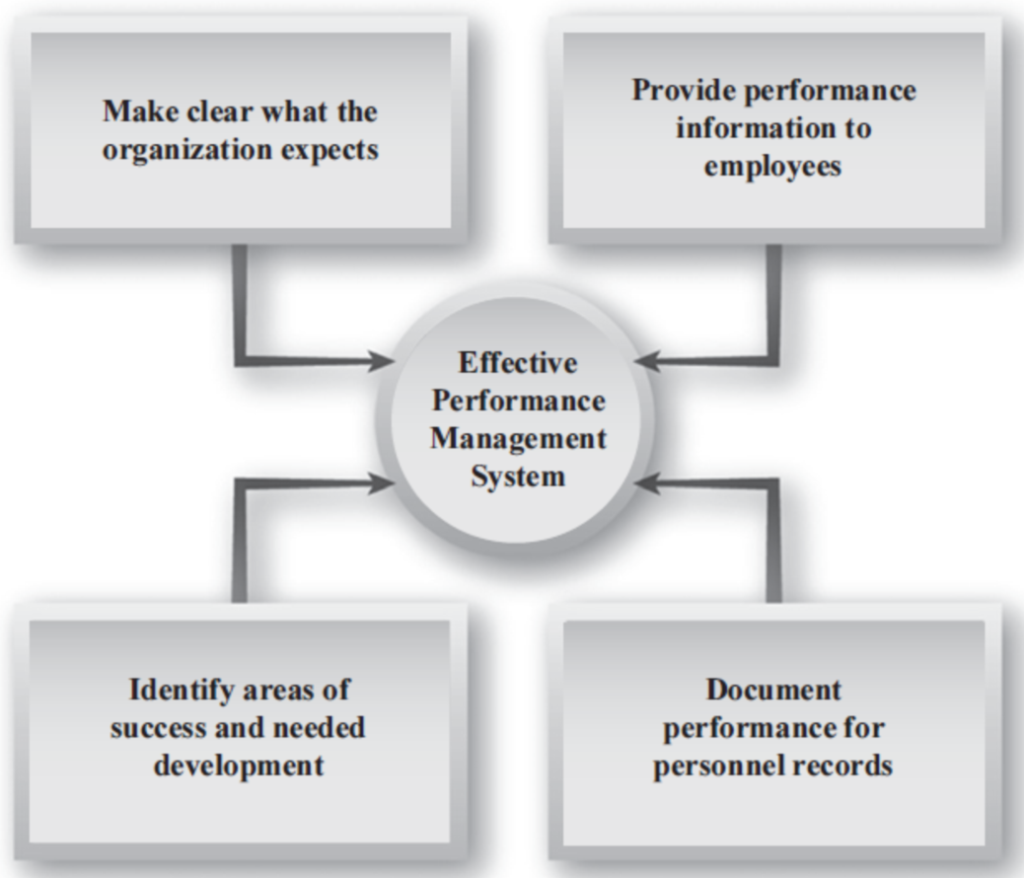
3. Role of Performance Management in Business Organization
- It leads to the improvement in the organization’s effectiveness
- It provides useful information to managers in their attempts to meet organizational goals and objectives
- It provides useful information on the following four key indicators :
- financial perspective
- customer perspective
- internal business perspective
- innovation and learning
- To diagnose the individual & organizational competencies so that actions can be taken on problem areas
- To define training requirements based on the individual competencies
4. Significance of Performance Management
- Competitive Business Environment
- Org. required to deal with performance related issues due to competition
- Human resource is the most significant source, so PMS is very essential
- Business HR partnership
- Contribution to bottom line in terms of profits, sales and turnover
- Utility of HR for effective functioning of organization in terms of work culture, employee’s performance and availability of HR
- Fulfilment of HR Needs
- Motivate employees to meet their self-esteem and self-actualization needs
- Performance management as Core of HR
- Performance driven practices such as rewards, career, team building lie in the heart of Human resource
- These practices are capable of leading HR function into strategic domain of organization
- Integrated Motivational Tool
- Capable of converting the latent potential of human resource into more tangible and contextual performances
- It is the key to motivate employees
- Higher performance Work Culture
- Promotes openness, trust, collaboration, proactivism and empathy
- Essential ingredients for leading people to maximize their performances
5. Principles of Performance Management
- Creating a “Win-Win” Environment
- Mutual understanding and clarity of expectations at the outset
- Proactive employee participation throughout all phases of the process
- Balanced and constructive feedback to facilitate employee development
- Shared ownership and commitment to success: employees and managers
- Focus maximizing contribution in current role
6. Goals of Performance Management
- An Ongoing, Two-Way Communication Process
- A Clarification of Expectations
- A Sincere Discussion of Opportunities for Skill Development
- A Way to Focus on Behaviour That Will Have the Most Impact on Organizational Results
- The Fostering of Improved Performance in the Current Job
- Working Smarter… Not Harder
7. Performance Appraisal
According to Flippo, a prominent personality in the field of Human resources,
“Performance appraisal is the systematic, periodic and an impartial rating of an employee’s excellence in the matters pertaining to his present job and his potential for a better job.”
Performance appraisal is a systematic way of reviewing and assessing the performance of an employee during a given period of time and planning for his future.
It is a powerful tool to calibrate, refine and reward the performance of the employee. It helps to analyze his achievements and evaluate his contribution towards the achievements of the overall organizational goals.
By focusing the attention on performance, performance appraisal goes to the heart of personnel management and reflects the management’s interest in the progress of the employees.
PAS (Performance Appraisal System) is formulated to :
- Development areas for concentration
- Review Clarify job description and responsibilities
- Clarify employee development interests and needs
- List specific performance objectives and performance standards

8. Objectives of Performance Appraisal
The main focus should be on developmental and not on judgmental aspects
Performance appraisal system can serve the following purposes :
- To review the performance of the employees over a given period of time.
- Enable each employee to understand his role better and become more effective on the job.
- To judge the gap between the actual and the desired performance.
- To help the management in exercising organizational control.
- Helps to strengthen the relationship and communication between superior – subordinates and management – employees.
- To diagnose the strengths and weaknesses of the individuals so as to identify the training and development needs of the future.
- To provide feedback to the employees regarding their past performance. To provide opportunity to the employee for introspection, self-evaluation and goal setting, so that he remains in the path of development.
- Provide information to assist in the other personal decisions in the organization.
- Provide clarity of the expectations and responsibilities of the functions to be performed by the employees.
- To judge the effectiveness of the other human resource functions of the organization such as recruitment, selection, training and development.
- To reduce the grievances of the employees and be an instrument for creating a positive and healthy climate in the organization that moves people to give their best and enjoy doing so.
- Provide inputs to system of rewards comprising salary increments. Appreciation, additional responsibilities, promotion and salary administration.
- Identifying the strengths and weakness of an employee it serves as a guide for formulating a suitable training and development programme.
- The objective is to integrate company and individual goals through a process of performance assessment linked to organisational objectives to distinguish between differing levels of performance on relative basis.
- To identify executives with potential to grow in the organisation.
- To chalk out developmental strategy to bring about improvement in the performance of the employee.
9. Difference between Performance Appraisal and Performance Management
9.1 Performance Appraisal
Process used to identify, encourage, measure, evaluate, improve and reward employee performance
- “Event” that focuses on year-end rating by manager
- Typically judgmental and focuses on activities, behaviour, personality
- Backward looking
- Process “owned” by Human Resources function
9.2 Performance Management
The process of evaluating how well employees perform their jobs and then communicating that information to the employees
- Future oriented, starts with planning discussions at beginning of year
- Individual’s plans tied to business unit performance plans
- Individual performance rating linked to rating of business unit
- Process “owned” by unit manager


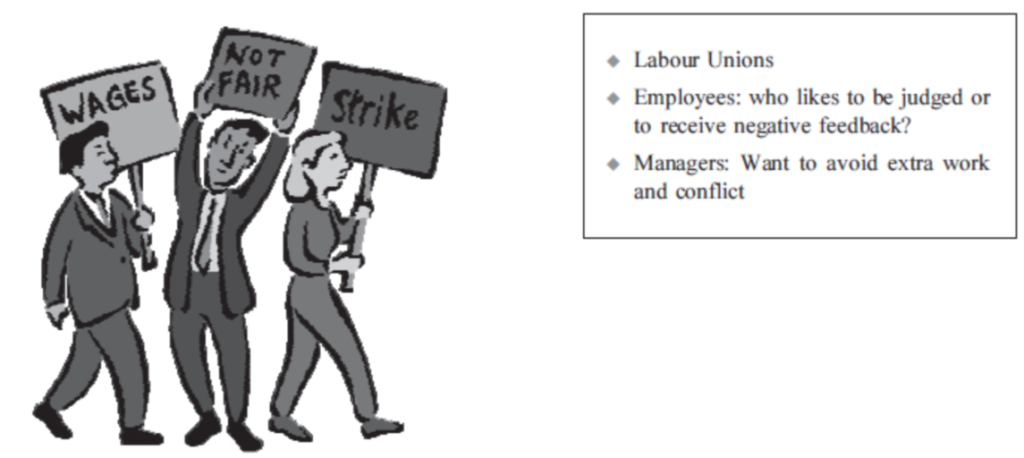
10. Sample Performance Appraisal Form
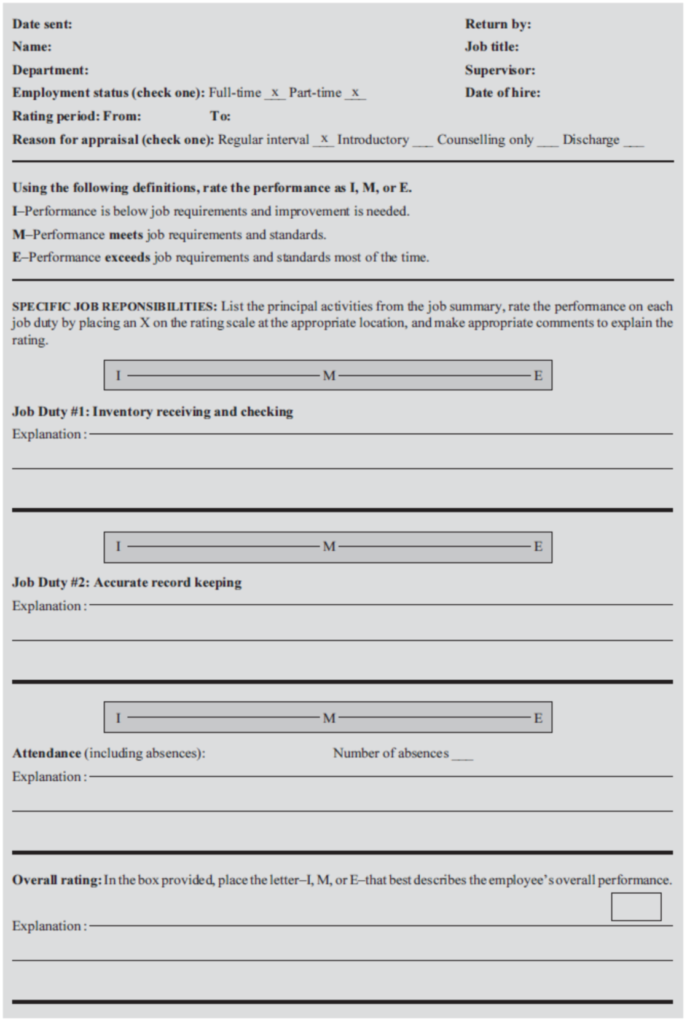
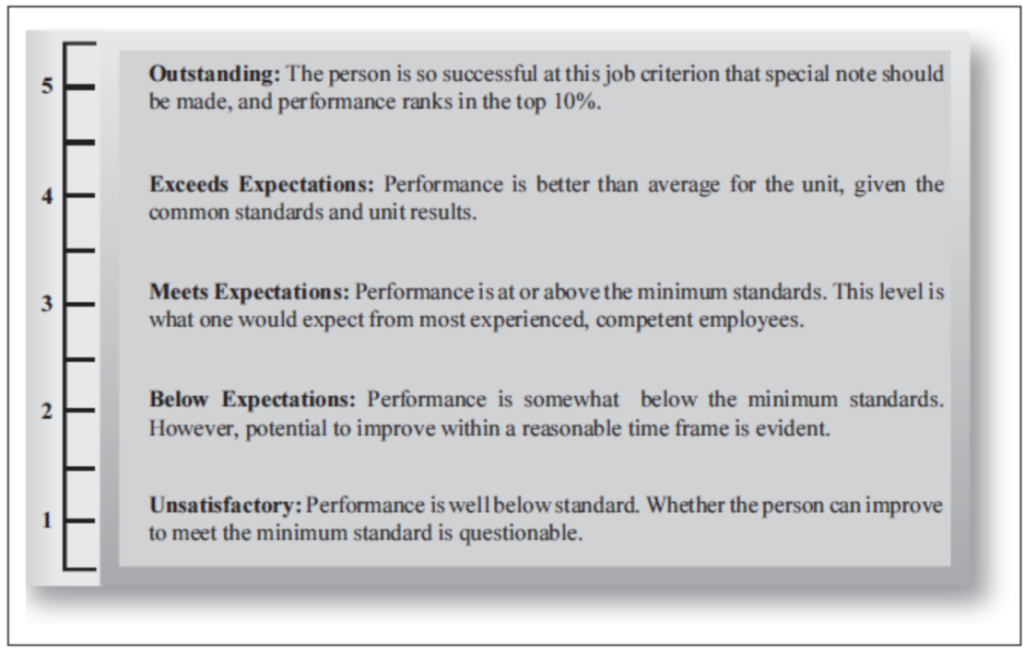

11. Appraisal Interview Hints for Supervisors and Managers
Do
- Prepare in advance
- Focus on performance and development
- Be specific about reasons for ratings
- Decide on specific steps to be taken for improvement
- Consider the supervisor’s role in the subordinate’s performance
- Reinforce desired behaviours
- Focus on future performance
Do Not
- Do all the talking
- Lecture the employee
- Mix performance appraisal and salary or promotion issues
- Concentrate only on the negative
- Be overly critical or “harp on” a failing
- Feel it is necessary for both parties to agree in all areas
- Compare the employee with other
12. Conducting Performance Review
12.1 Performance
- Any recognized accomplishment
- Process or manner of functioning or operating
- The act of performing; of doing something successfully; using knowledge as distinguished from merely possessing it
12.2 Review
- Look at again; examine again
- Appraise critically
- Look back upon (a period of time, sequence of events); remember
- Practice intended to polish performance or refresh the memory
- A summary at the end that repeats the substance of a longer discussion
12.3 Characteristics
- Forward looking.
- More developmental than evaluative.
- Focused on improvement in performance behaviours and outcomes.
- Anchored to “Great Performance” outcomes and goals that are defined early in the performance cycle.
- Employee Centered.
- Frequent: conducted as often as necessary to keep performance on track and getting it back on track if and when problems occur.
- Conversational and informal leading to a shared understanding
- Based upon a Mutual Learning Mindset vs. a Unilateral Control Mindset.
- Objective and data-based: using observable and countable behaviours and results as its foundation.
- Meaningful both the performer and the supervisor have learned something about themselves and each other.
13. Steps to Effective Review
- Adopt a Mutual Learning Mindset as a performance coach and as a performer.
- Establish an overarching framework for defining and managing performance.
- Evaluate and update the performer’s job description.
- Mutually discuss and define great performance outcomes, goals, behaviours and measures.
- Discuss and define mutual expectations that each of you have for the performance partnership
- Monitor performance outcomes and document performance results.
- Discuss performance issues as they arise.
- Follow-through on commitments that each have made to support the performer in achieving his or her great performance outcomes and goals.
- Prepare for the performance coaching conversation.
- Navigate the performance coaching conversation.
14. Key Performance Review Questions
- What is going well with the job?
- What NOT going well in the job?
- Why is/isn’t this going well?
- What changes or improvements could you make in how you do your job to help improve things that are not going well?
- How might I (your supervisor/coach) help you to be more successful in your job?
- What do you see as performance areas where there may be a need for new responsibilities and future growth in performance?
- How would you assess your overall performance and your performance for each of your job and organizational responsibilities?
15. Prerequisites for Effective & Successful Performance Appraisal
The essentials of an effective performance system are as follows:
Documentation – means continuous noting and documenting the performance. It also helps the evaluators to give a proof and the basis of their ratings.
Standards/Goals – the standards set should be clear, easy to understand, achievable, motivating, time bound and measurable.
Practical and simple format – The appraisal format should be simple, clear, fair and objective. Long and complicated formats are time consuming, difficult to understand, and do not elicit much useful information. Identification of Key Performance Areas (KPAs) and target setting should be done periodically.
Evaluation technique – An appropriate evaluation technique should be selected; the appraisal system should be performance based and uniform. The criteria for evaluation should be based on observable and measurable characteristics of the behaviour of the employee.
Communication – Communication is an indispensable part of the Performance appraisal process. The desired behaviour or the expected results should be communicated to the employees as well as the evaluators. Open communication system motivates the employees to actively participate in the appraisal process. Performance discussions and counselling should be done.
Feedback – The purpose of the feedback should be developmental rather than judgmental. To maintain its utility, timely feedback should be provided to the employees and the manner of giving feedback should be such that it should have a motivating effect on the employees’ future performance.
Personal Bias – Interpersonal relationships can influence the evaluation and the decisions in the performance appraisal process. Therefore, the evaluators should be trained to carry out the processes of appraisals without personal bias and effectively.
16. Effective Performance Management System

A properly designed appraisal system contains three principal elements
- There is the statement of performance objectives for the individual (this describes the outcomes expected of Team members, how they are measured and when they are to be completed).
- There is a statement of the specific support to be provided by the team leader (special skills the team leader can assist with and the training required).
- There is the appraisal interview itself (it is a Review of performance in an overall way against the Previously agreed outcomes).
The key elements for perfect Appraisal system include
- A key element of the “perfect appraisal system” is it’s mutually.
- Team members and their team leader must take responsibility for making the overall relationship work.
- It is also important to make sure that the appraisal system is simple performance appraisal systems should become an integral part of the work of a team.
17. Characteristics of a High Performance Work System
- An organization that works better and spends less
- One that can achieve significant results for the money spent
- A business that provides value to the customers and stakeholders
- An organization that delivers products and services on time, and
- One that achieves recognition for the services it provides.
Typically, Performance Appraisal is aimed at:
- To review the performance of the employees over a given period of time.
- To judge the gap between the actual and the desired performance.
- To help the management in exercising organizational control.
- To diagnose the training and development needs of the future.
- Provide information to assist in the HR decisions like promotions, transfers etc.
- Provide clarity of the expectations and responsibilities of the functions to be performed by the employees.
- To judge the effectiveness of the other human resource functions of the organization such as recruitment, selection, training and development.
- To reduce the grievances of the employees.
- Helps to strengthen the relationship and communication between superior – subordinates and management – employees.
There is always scope of improvement for continuous reinforcing development of employee
– Active participation of employees in the whole process
– Interviewer should adopt a positive and supportive attitude
– Interviewer should focus on specific job issues, not personality characteristics
– Should try to establish joint and specific goals
– Employee should have right to question, challenge, and rebut evaluation without fear of retribution
– Discussion of salary and rank changes should be linked directly to performance appraisal criteria
The process is very much cyclical and continuous in nature. A performance management system includes the following actions:
- Developing clear job descriptions and employee performance plans which includes the key result areas (‘KRA’) and performance indicators.
- Selection of right set of people by implementing an appropriate selection process.
- Negotiating requirements and performance standards for measuring the outcome and overall productivity against the predefined benchmarks.
- Providing continuous coaching and feedback during the period of delivery of performance.
- Identifying the training and development needs by measuring the outcomes achieved against the set standards and implementing effective development programs for improvement.
- Holding quarterly performance development discussions and evaluating employee performance on the basis of performance plans.
- Designing effective compensation and reward systems for recognizing those employees who excel in their jobs by achieving the set standards in accordance with the performance plans or rather exceed the performance benchmarks.
- Providing promotional/career development support and guidance to the employees.
- Performing exit interviews for understanding the cause of employee discontentment and thereafter exit from an organization.
A performance management process sets the platform for rewarding excellence by aligning individual employee accomplishments with the organization’s mission and objectives and making the employee and the organization understand the importance of a specific job in realizing outcomes. By establishing clear performance expectations which includes results, actions and behaviours, it helps the employees in understanding what exactly is expected out of their jobs and setting of standards help in eliminating those jobs which are of no use any longer. Through regular feedback and coaching, it provides an advantage of diagnosing the problems at an early stage and taking corrective actions.
18. The Purpose of the PAS
- Provide basis for promotions, transfers Identify high potential employees.
- Identify training and development opportunities
- Identify training and development need establish supervisor employee agreement on expectations
- Guide the employees as how to achieve objectives
- Diagnosing strengths and weakness determine a development plan for improving job performance define the behavioural aspects of performance and
- Analyze performance.
Assessment and evaluation of goals
- Provide feedback to employees on where they stand
- Coaching and development goals
- Counsel and coach employees to develop future potential
- Develop commitment through discussion
- Motivate subordinates through recognition and support
- Strengthen supervisor-subordinate relations
- Diagnose individual and organizational problems.
19. Performance Management Linkage

Performance Appraisal is being practiced in 90% of the organizations worldwide. Self-appraisal and potential appraisal also form a part of the performance appraisal processes.
According to a recent survey, the percentage of organizations (out of the total organizations surveyed i.e. 50) using performance appraisal for the various purposes are as shown in the diagram below:
The most significant reasons of using Performance appraisal are:
- Making payroll and compensation decisions – 80%
- Training and development needs – 71%
- Identifying the gaps in desired and actual performance and its cause – 76%
- Deciding future goals and course of action – 42%
- Promotions, demotions and transfers – 49%
- Other purposes – 6% (including job analysis and providing superior support, assistance and counselling)
Factors affecting Performance Appraisal
- Environment Constraints
- Organizational Leadership
- Interdependence of sub-system
- Organizational Structure
20. Components of Performance Focused Culture

21. Techniques of Performance Appraisal
- Graphic rating scales (Employees are rated on a scale, usually from 1 to 10)
- Management by Objectives Wherein objectives are set, plans are determined, performance is reviewed and rewards are given Simple ranking
- Wherein reporting officers simply rank their subordinates from best to worst on their performances
- Critical incidents in which raters identify critical positive and negative employee performance
- Essay in which performances are described in essays form
Some tips for team members/employees
- Work towards an honest open relationship
- Two way feedback is a constant feature of your relationship with your team leader
- Provide feedback to your leader about the extent to which he or she has supported you and the team
- If goals and outcomes are not clear to you for any reason, ask. For it. Make sure you know what is to be done, to what standard and by when. Ask for the level of support you feel you need, resources, authority, personal coaching, etc.
- If your team leader is focusing on the past, ask what specific outcomes he or she might want of you to avoid the “problem” in the future.
- Indicate your commitment to meet the performance outcomes agreed.
Tips for reporting officers (supervisor)
- Work towards an honest open relationship with two-way feedback
- Spend time in understanding your team member’s values
- Provide day-to-day feedback to your team about their performance
- Understand the level of skill your team has in doing the task
- Understand the motivational level of the team
22. Criteria of Performance Management
- Job analysis
- Criterion development
- Performance appraisal
23. Process of PA
- Establish performance standards
- Communicate performance expectations to employees
- Measure actual performance
- Compare actual with standards
- Discuss appraisal with employees
- Corrective measures

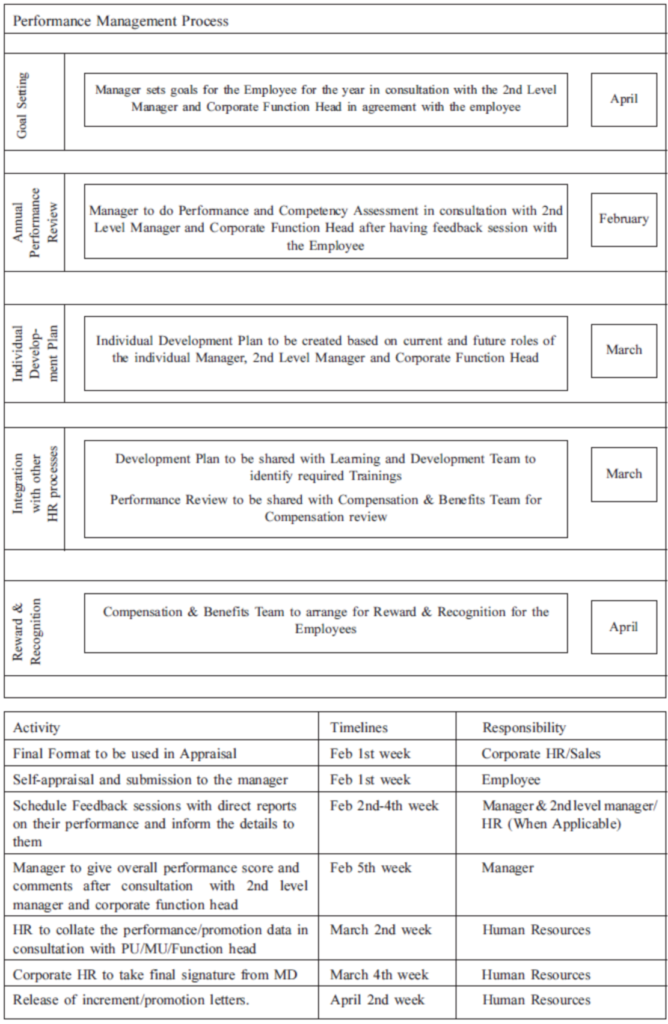
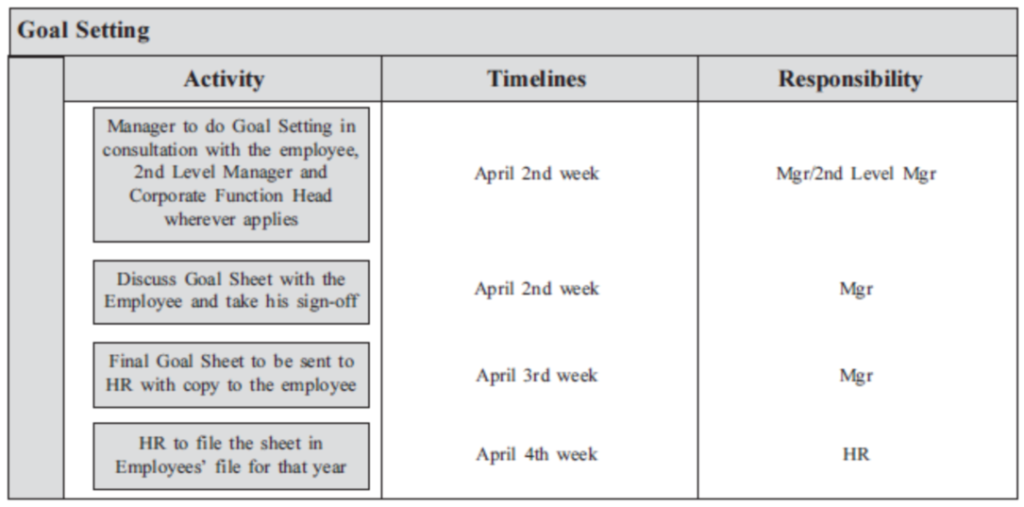
24. Different Methods of Appraisals
Objective Methods
- Quantity and quality of output: environmental factors, job difficulty
- Electronic Performance Monitoring
- ½ of workers are currently monitored continuously
- Is it used to improve work quality?
- Many believe that it makes evaluation more objective
- Job Related Personal Data : Absenteeism, accidents, tardiness
Judgmental Appraisal Methods
- Written Narrative Appraisals: may be ambiguous or misleading
- Ratings Scales
- Ranking Techniques: workers are all ranked from best to worst
- Doesn’t work for large #’s of employees
- Less information than ratings
- Forced Distribution Technique: Rate employees on curve
- What if all workers deserve good ratings?
- Forced Choice Scales: Must choose from equally favourable/unfavourable statements (only one of which is correlated with job performance)
- BARS (Behaviourally Anchored Rating Scales): evaluate performance in terms of critical employee behaviours
- MBO (Management by Objective): Mutually agreed upon goals
Appraisal of Managers
- Assessment Centre : simulated job activities
- Evaluation by Superiors
- Peer Ratings: Good predictors of promotion
- Self-Evaluation: Leniency is a concern
- Evaluation by Subordinates: upward feedback. Good predictor of managerial success. Must be anonymous
- 360 Degree Feedback: Combines evaluations from a number of sources

25. Traditional Methods of Performance Appraisal
- Graphic Rating Scale: Scales consisting of a number of traits or behaviours that the rater must judge based on where the employee falls on this dimension regarding expectations. e.g. Emotional stability, knowledge, creativity, discipline. A trait like Job Knowledge may be judged on the range of average, above average, outstanding or unsatisfactory.
A form is used to evaluate the performance of the employees. A variety of traits may be used in this device, the most common being quality and quantity of work. It is easy to understand and use. It permits statistical tabulation of scores of employees.
- Checklist: The rater is given a checklist of the descriptions of the behaviour of the employees on job. The checklist contains a list of statements on the basis of which the rater describes on the job performance of the employees. A checklist is a set of objectives or descriptive statements about the employee and his behaviour.
- Under weighted checklist, value of each question may be weighted.
- Example:
- Is the employee really interested in the task assigned? Yes/No
- Is he respected by his colleagues? Yes/No
- Forced Choice Method: This method uses several sets of paired phrases, two of which may be positive and two negative. The rater is asked to indicate which of the four phrases is the most and least descriptive of a particular worker. Favourable qualities on plus credit and unfavourable ones earns the reverse.
- Forced Distribution Method: The rater is asked to appraise the employee according to predetermined distribution scale. Two criteria used for rating are: job performance and promotability. A five point performance scale is also used without mentioning any descriptive statements. The worker is placed between two extremes of “good” and “bad” performance.
- Behaviourally Anchored Rating Scale: Generate critical incidents (examples of good and poor job performance). Place Critical Incidents Into performance dimensions (e.g., Responsibility, Initiative, Safety). Retranslation Step (do step # 2 again with a separate group of job experts. Discard incidents where disagreement exists as to which dimension in which they belong). Calculate the mean and standard deviation of each critical incident (discard those with a large standard deviation). Place critical incidents on a vertical scale.
- Field Review: In this method, a senior member of the HR department or a training officer discusses and interviews the supervisors to evaluate and rate their respective subordinates. A major drawback of this method is that it is a very time consuming method. But this method helps to reduce the superiors’ personal bias.
- Essay appraisal method :This traditional form of appraisal, also known as “Free Form method” involves a description of the performance of an employee by his superior. The description is an evaluation of the performance of any individual based on the facts and often includes examples and evidences to support the information. A major drawback of the method is the inseparability of the bias of the evaluator.
- Paired comparison :A better technique of comparison than the straight ranking method, this method compares each employee with all others in the group, one at a time. After all the comparisons on the basis of the overall comparisons, the employees are given the final rankings.
26. Modern Methods of Performance Appraisal
- Management by Objectives (MBO): The concept of ‘Management by Objectives’ (MBO) was first given by Peter Drucker in 1954. It can be defined as a process whereby the employees and the superiors come together to identify common goals, the employees set their goals to be achieved, the standards to be taken as the criteria for measurement of their performance and contribution and deciding the course of action to be followed
It reflects a management philosophy which values and utilizes employee contributions.
Steps in MBO:
-
- Establish the goals each subordinate is to attain (sometimes collectively set by superiors and subordinates)
- Setting the performance standards for the subordinates in specified time period.
- Actual level of goal attainment is compared with the goals agreed upon. (causes are explored to assess the training needs)
- Establishing new goals specifically with the subordinates who easily attained previously set goals. New strategies are also explored. Then, the whole step is repeated.
The essence of MBO is participative goal setting, choosing course of actions and decision making. An important part of the MBO is the measurement and the comparison of the employee’s actual performance with the standards set. Ideally, when employees themselves have been involved with the goal setting and the choosing the course of action to be followed by them, they are more likely to fulfil their responsibilities.
27. The MBO Process

28. Features and Advantages MBO
The principle behind Management by Objectives (MBO) is to create empowered employees who have clarity of the roles and responsibilities expected from them, understand their objectives to be achieved and thus help in the achievement of organizational as well as personal goals.
Some of the important features and advantages of MBO are:
- Clarity of goals – With MBO, came the concept of SMART goals i.e. goals that are:
- Specific
- Measurable
- Achievable
- Realistic, and
- Time bound.
The goals thus set are clear, motivating and there is a linkage between organizational goals and performance targets of the employees.
- The focus is on future rather than on past. Goals and standards are set for the performance for the future with periodic reviews and feedback.
- Motivation – Involving employees in the whole process of goal setting and increasing employee empowerment increases employee job satisfaction and commitment.
- Better communication and Coordination – Frequent reviews and interactions between superiors and subordinates helps to maintain harmonious relationships within the enterprise and also solve many problems faced during the period.
- Psychological Appraisal: Large organisations employ full-time industrial psychologists. They assess an individual’s future potential.
Disclaimer: The content/information published on the website is only for general information of the user and shall not be construed as legal advice. While the Taxmann has exercised reasonable efforts to ensure the veracity of information/content published, Taxmann shall be under no liability in any manner whatsoever for incorrect information, if any.

Taxmann Publications has a dedicated in-house Research & Editorial Team. This team consists of a team of Chartered Accountants, Company Secretaries, and Lawyers. This team works under the guidance and supervision of editor-in-chief Mr Rakesh Bhargava.
The Research and Editorial Team is responsible for developing reliable and accurate content for the readers. The team follows the six-sigma approach to achieve the benchmark of zero error in its publications and research platforms. The team ensures that the following publication guidelines are thoroughly followed while developing the content:
- The statutory material is obtained only from the authorized and reliable sources
- All the latest developments in the judicial and legislative fields are covered
- Prepare the analytical write-ups on current, controversial, and important issues to help the readers to understand the concept and its implications
- Every content published by Taxmann is complete, accurate and lucid
- All evidence-based statements are supported with proper reference to Section, Circular No., Notification No. or citations
- The golden rules of grammar, style and consistency are thoroughly followed
- Font and size that’s easy to read and remain consistent across all imprint and digital publications are applied





